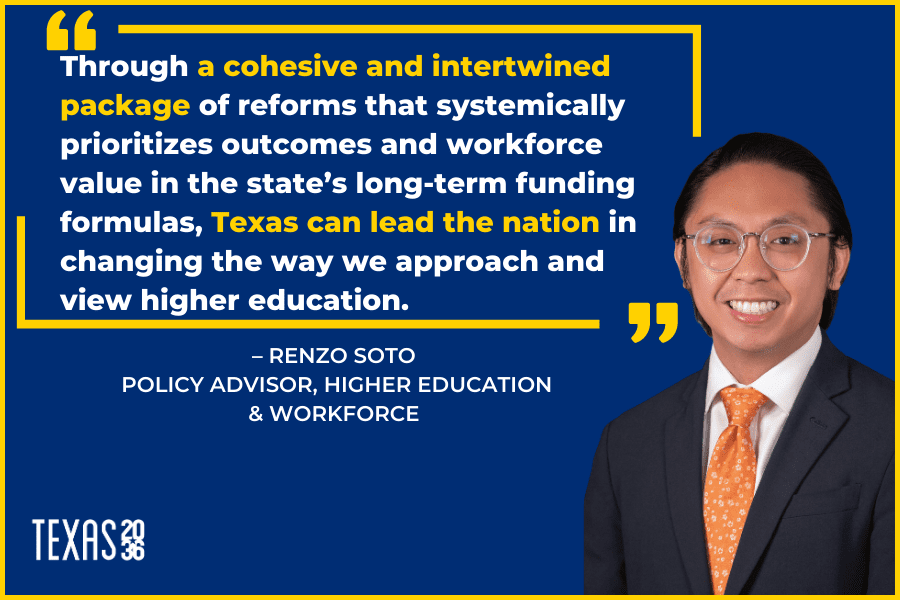Shaping the workforce of Texas’ future
This is a preview of our Texas 2036 newsletter that highlights initiatives to support efforts to shape the workforce of tomorrow. To receive this weekly look at our work, sign up here.
 Shaping Tomorrow’s Workforce 👷♀️👨🏫👩⚕️
Shaping Tomorrow’s Workforce 👷♀️👨🏫👩⚕️
Texas 2036 is pioneering initiatives to cultivate a resilient, future-ready workforce where more Texans earn a family-sustaining wage.
Here are some of the compelling questions for which we’re aiming to provide data-driven answers during our preparations for the 2025 legislative session:
- How can we reform the high school experience to get more students ready for college or career after graduation by improving how we measure student performance while maintaining the system’s rigor?
- How can we enhance the value of Texas’ workforce data ecosystem for diverse stakeholders and support education and workforce development providers, employers, and students and workers through an improved system?
- How can we optimize the performance of education and workforce development programs for veterans, formerly-incarcerated individuals, and other Texans seeking high-quality employment to ensure effective delivery of results that meet taxpayers’ and employers’ expectations?
Bridging the gap: Educational attainment and workforce

Texas 2036 commissioned a report by Alexander Research & Consulting seeking to identify multiple long-term, forward-looking trends that will impact workforce demand in Texas.
Here are some of the key takeaways from the recently released report:
Demand for workers with postsecondary credentials is rising: More and more jobs require a postsecondary credential — anything from a certificate to a bachelor’s degree or higher.
- At the same time, 90% of occupations that require a high school diploma or less also require on-the-job training, which are increasingly provided through formal training programs offered by higher education institutions like community colleges.
Industries of opportunity drive workforce demand: Health care, education, finance and insurance, transportation and warehousing, and oil and gas are Texas’ top industries of opportunity and are important drivers of workforce demand. These sectors are significant in size and either primary sources of growth or employment or both.
Texas’ educational infrastructure must be aligned with workforce demand: Elements of the state’s educational infrastructure — which include apprenticeships and career and technical education in addition to postsecondary academic degrees — could be more widely utilized and better aligned with Texas’ industries of opportunity.
Labor force trends highlight challenges ahead: A persistent, more than 10 percentage point disparity between women’s and men’s labor force participation rates remains, and future gains could be affected by the availability of childcare.
- Hispanic workers represent one of the most rapidly growing segment of the Texas labor force, but the educational attainment of this group lags the rest of the adult population.
Community colleges: A new approach on workforce
We’ve written previously on the Legislature’s passage of House Bill 8 that invests $691 million and commits the state’s community colleges to a new approach in equipping their students with the skills to fill the high-paying jobs of the future.

Texas 2036 policy advisor Renzo Soto breaks down the following areas where the new legislation seeks to align a community college education with the outcomes needed to produce a highly-skilled workforce:
Aligning funding to student outcomes: The previous enrollment-driven funding formulas presented many challenges for the state’s community colleges, and became increasingly misaligned with employers’ workforce needs.
- The state responded by overhauling this enrollment-based system to more directly tie community college funding to student completion of a postsecondary credential that has proven workforce value. Lawmakers directed $428 million of the $691 million included in HB 8’s investment package to ease the transition for community colleges and shift their focus to improving students’ outcomes as soon as the start of the 2023-24 academic year. This new system based on documented improvements of students’ outcomes has great potential to vastly improve the skilled Texas labor force.
Providing more support for community colleges: To accelerate the alignment of community colleges’ course offerings with workforce demands, lawmakers also took steps this year to build up the capacity of community colleges to meet the demands of Texas students and employers.
- Lawmakers appropriated $33 million of the $691 million for innovation and collaboration efforts, including to start or expand short-term credential programs aligned with regional and statewide workforce needs.
Expanding opportunities to more Texans: Non-economically disadvantaged students go on to enroll in postsecondary education at much higher rates than economically disadvantaged students — 64% compared to 43%. Closing this gap will require removing as many barriers to enrollment as possible, particularly cost barriers.
- Lawmakers this year invested more than $200 million of the $691 million into financial aid and student supports with the goal of lowering barriers to a postsecondary education.
 🤠 It’s your turn, Texas:
🤠 It’s your turn, Texas:
What do you think are the jobs of the future?
Let us know in our quick survey!
If you love our work, consider making a donation.

